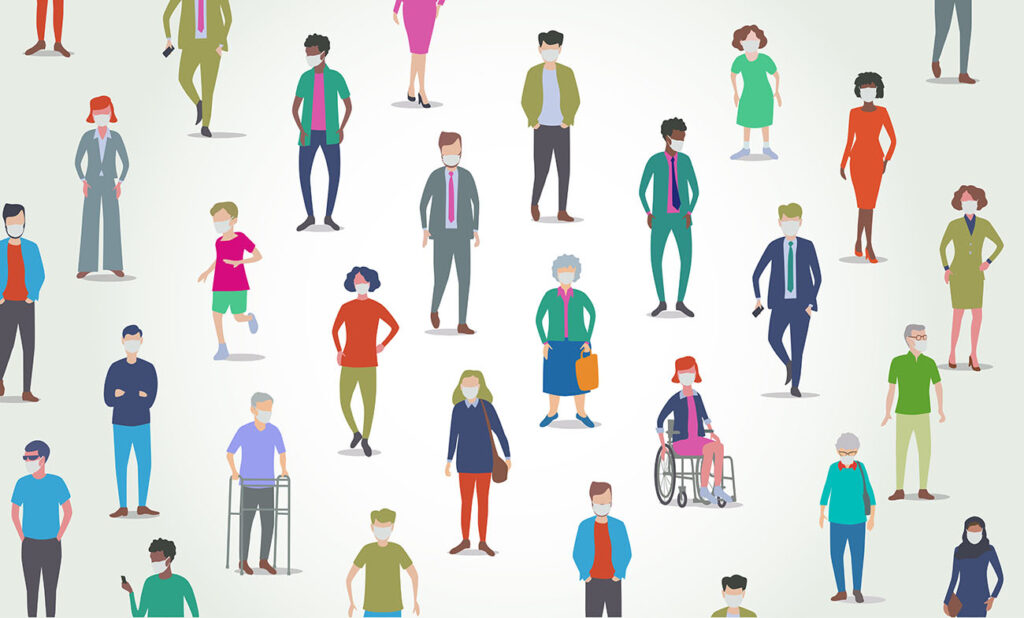The CatalystConversations on Mental Health
Subscribe to Catalyst
Subscribe to get our magazine delivered right to your inbox
Related Articles
Understanding re-entry anxiety with Dr. Keith Dobson
The coronavirus pandemic has introduced a long list of reasons to feel anxious. For months the country has been in virtual lockdown, with physical distance separating us from each other and turning the world as we knew it on its head. Now, as the country begins to reopen, new concerns are emerging, and return or re-entry anxiety is setting in for many.
“I think there are going to be two main types of reactions,” said Dr. Keith Dobson, professor of clinical psychology at the University of Calgary. “One will be the ongoing stresses and anxiety associated with COVID-19. These include renegotiating social norms to ensure safe distancing, deciding when it is safe to send children to school, and coping with fears of possible new waves or outbreaks of infection.”
While concerns over physical health and safety are plentiful and can cause strong stress reactions, there are a host of other, more individual stressors as well. “The second big issue,” said Dobson, “is facing the reality of the personal and economic losses associated with the pandemic.” For some, this will mean venturing out into a job market they weren’t prepared to explore. For others, anxiety could come from losing some of the benefits of quarantine, such as remote work and more free time.
One thing is certain — re-opening the country doesn’t mean the same thing for everyone. As we begin to see more restrictions lifted, it will be important to recognize that what feels positive for one person might feel like a setback for someone else.
According to Dobson, a good example of this disparity occurs in the feelings toward increased social freedom. “For many people, increased social interaction will help ease the anxiety of the readjustment period. But for those who fear social situations to begin with, like someone with social anxiety disorder or a heightened concern about contamination from others, the additional social interaction will increase anxiety.”
Acknowledging the wide-ranging responses to a gradual re-opening is especially important for employers that are considering the transition back to an office environment. For Louise Bradley, president and CEO of the Mental Health Commission of Canada, that balancing act has been top of mind. “The most important thing we can do for our staff is to listen,” she said. “We’ve conducted surveys and one-to-one interviews to try to establish what’s working for people, where more accommodations are required, and what appetite there is, if any, for a return to the office.”
Bradley is quick to point out that, for a lot of knowledge organizations, remote work is proving effective, albeit imperfect. “The proof is in the pudding, to put it plainly. We’ve demonstrated a remarkable ability to flex and adapt, and be as productive as ever. But we can’t assume that what’s working for one person is working for the next. Communication has to be very thoughtful and deliberate right now — that alone can help reduce stress and clarify expectations.”
There are also things we can do as individuals to help curb return anxiety, explained Dobson. “The single best evidence-based treatment for anxiety is exposure, which involves slowly confronting the thing or situation you’re afraid of. Gradual exposure allows you to readjust your appraisal of the risk associated with the fear, slowly reducing anxiety over time.”
While we don’t want to expose ourselves to the virus itself, slowly and safely confronting the uncomfortable elements of re-entry, such as social interactions or spending time in public, can help reduce the overall anxiety toward a post-lockdown reality.
Another important part of offsetting return anxiety is continuing to follow the advice of health authorities. As Dobson put it, “We need to also learn to take appropriate risks again. It’s important that people do not continue to use COVID-19 as a reason to avoid things health authorities have deemed low-risk.” Take comfort in knowing that by adhering to public health guidelines, you’re following the best available advice to ease back into the world safely.
To safeguard our mental health during this transition, we must also remember to temper our expectations. Things will look different for a while — there’s no way around it. To avoid disappointment or feeling overwhelmed, plan ahead whenever possible. Discuss the boundaries of social gatherings with loved ones, find out what safety measures to expect at work and in public, and anticipate some discomfort.
Anxiety may be familiar to some of us, but this transition is new for all of us.
Amber St. Louis
Most recent
Breaking Barriers
Systems need to hear from those they serve – these advocates and leaders drive policy change and push for cultural awareness and lived experience in decision-making. Meet the Mental Health Commission of Canada Youth Advisory Council Co-Chairs: Em Alexander and Colbi Mike.
Read more“Unhoused” and “Homeless” – What’s the Difference?
The best advice from advocates: talk about the issues and use terms that people use to refer to their own lived experience.
Read moreA Strategic Approach to E-Mental Health
Hard-and-fast rules have eluded the burgeoning field of electronic mental health. Canada’s First E-Mental Health Strategy offers practical tools and recommendations.
Read more




